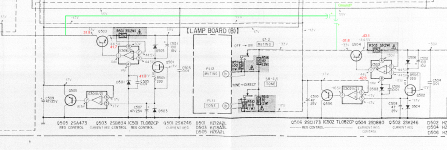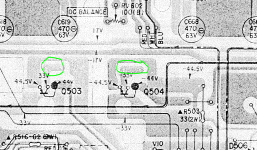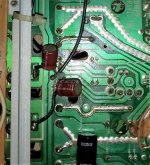Hello,
I have a Sony TA-AX7 and two transistors (q503, q504) get very hot. Which results in that the amplifier gets almost too hot to touch, even idle. I checked and set the bias and dc offset according to the service manual and this didn't solve the issue. Besides that, I replaced most of the electrolyte capacitors.
Next to this it seems like a modification has been made to the circuit, since 2 capacitors have been added. These 2 caps of 10uf are not mentioned anywhere in the technical drawings. In the attached image I added this part in green. Can I remove this safely or does it have an important function? Next to this I measured the voltages, those where slightly off and I have added those in red
Currently I do not know what could cause the issue, so help would be welcome. Do you have any idea what I can check right now to identify what is causing this?
in the link I have put the schematic diagram, the problematic transistors can be found at location 5E.
service_manual_ta_ax7.pdf - Google Drive
Thanks in Advance!
I have a Sony TA-AX7 and two transistors (q503, q504) get very hot. Which results in that the amplifier gets almost too hot to touch, even idle. I checked and set the bias and dc offset according to the service manual and this didn't solve the issue. Besides that, I replaced most of the electrolyte capacitors.
Next to this it seems like a modification has been made to the circuit, since 2 capacitors have been added. These 2 caps of 10uf are not mentioned anywhere in the technical drawings. In the attached image I added this part in green. Can I remove this safely or does it have an important function? Next to this I measured the voltages, those where slightly off and I have added those in red
Currently I do not know what could cause the issue, so help would be welcome. Do you have any idea what I can check right now to identify what is causing this?
in the link I have put the schematic diagram, the problematic transistors can be found at location 5E.
service_manual_ta_ax7.pdf - Google Drive
Thanks in Advance!
Attachments
The transistor are low frequency DC regulators. They are TO220, so add a heat sink, with some compound. PN 273-rb should work. Sony didn't sell all those units by spending $1 when it wasn't necessary. You'll need a #4 screw & nut or a 3mm same.
Leaky e-caps down stream could increase the load on this regulator, but since you replaced those I wouldn't worry about it. 2sb834 lasted this long, shows good engineering right at the edge of reliability.
I wouldn't worry about the extra caps. If sony put them in, must have been a reason.
All my used amps have had blown transistors, probably because of heat although shorted speaker wires might have been installed by users. The ST120, I was there the last time it failed, it wasn't the wiring, it was bad engineering with design right on the edge of usefulness. I add heat sinks to everything with blown transistors, to cut the # of times I have to go in there & repair them. VAS, drivers, regulators, all get little heat sinks. Just make sure shock of carrying can't bend the heat sink over to touch anything else. If so, use insulator under the heat sink.
A Pv-4c with 3 tech signatures on the output transistor heat sink, I added four TO3 heat sinks to the regular OT heat sink by drilling holes. Can't hurt.
Oscillation of the amp portions can cause excessive load on DC regulators. E-cap replacement doesn't usually cause that, but you had better check the collectors of the VAS & drivers for AC voltage with a shorted input. 0 is the right answer. A scope is nice, but a cheap analog VOM on 10 vac or 50 vac scale (with a .047 uf cap in the negative lead to block DC) can see ultrasound just as well. DVM no, the cheap ones produce random numbers on frequencies other than 50-60. The expensive rms dvms can't see above 7 khz.
Leaky e-caps down stream could increase the load on this regulator, but since you replaced those I wouldn't worry about it. 2sb834 lasted this long, shows good engineering right at the edge of reliability.
I wouldn't worry about the extra caps. If sony put them in, must have been a reason.
All my used amps have had blown transistors, probably because of heat although shorted speaker wires might have been installed by users. The ST120, I was there the last time it failed, it wasn't the wiring, it was bad engineering with design right on the edge of usefulness. I add heat sinks to everything with blown transistors, to cut the # of times I have to go in there & repair them. VAS, drivers, regulators, all get little heat sinks. Just make sure shock of carrying can't bend the heat sink over to touch anything else. If so, use insulator under the heat sink.
A Pv-4c with 3 tech signatures on the output transistor heat sink, I added four TO3 heat sinks to the regular OT heat sink by drilling holes. Can't hurt.
Oscillation of the amp portions can cause excessive load on DC regulators. E-cap replacement doesn't usually cause that, but you had better check the collectors of the VAS & drivers for AC voltage with a shorted input. 0 is the right answer. A scope is nice, but a cheap analog VOM on 10 vac or 50 vac scale (with a .047 uf cap in the negative lead to block DC) can see ultrasound just as well. DVM no, the cheap ones produce random numbers on frequencies other than 50-60. The expensive rms dvms can't see above 7 khz.
Last edited:
The transistor are low frequency DC regulators. They are TO220, so add a heat sink, with some compound. PN 273-rb should work. Sony didn't sell all those units by spending $1 when it wasn't necessary. You'll need a #4 screw & nut or a 3mm same.
Leaky e-caps down stream could increase the load on this regulator, but since you replaced those I wouldn't worry about it. 2sb834 lasted this long, shows good engineering right at the edge of reliability.
I wouldn't worry about the extra caps. If sony put them in, must have been a reason.
All my used amps have had blown transistors, probably because of heat although shorted speaker wires might have been installed by users. The ST120, I was there the last time it failed, it wasn't the wiring, it was bad engineering with design right on the edge of usefulness. I add heat sinks to everything with blown transistors, to cut the # of times I have to go in there & repair them. VAS, drivers, regulators, all get little heat sinks. Just make sure shock of carrying can't bend the heat sink over to touch anything else. If so, use insulator under the heat sink.
A Pv-4c with 3 tech signatures on the output transistor heat sink, I added four TO3 heat sinks to the regular OT heat sink by drilling holes. Can't hurt.
Oscillation of the amp portions can cause excessive load on DC regulators. E-cap replacement doesn't usually cause that, but you had better check the collectors of the VAS & drivers for AC voltage with a shorted input. 0 is the right answer. A scope is nice, but a cheap analog VOM on 10 vac or 50 vac scale (with a .047 uf cap in the negative lead to block DC) can see ultrasound just as well. DVM no, the cheap ones produce random numbers on frequencies other than 50-60. The expensive rms dvms can't see above 7 khz.
Thanks a lot for your help, currently they already have a significant heatsink, in case i can’t get the temperatures down, i will at a larger one. Unfortunate i don’t have an analogue VOM i'll try to get my hands on one so i can do what you suggest.
Regarding the extra caps, it really looks like they were added later, a different type of caps is used and the way it is fitted in the design looks a bit nasty. exposed wires which could easily short. See the picture. don’t worry i added some insulation after taking the photo 🙂
Attachments
Thanks a lot for your help, currently they already have a significant heatsink, in case i can’t get the temperatures down, i will at a larger one. Unfortunate i don’t have an analogue VOM i'll try to get my hands on one so i can do what you suggest.
Regarding the extra caps, it really looks like they were added later, a different type of caps is used and the way it is fitted in the design looks a bit nasty. exposed wires which could easily short. See the picture. don’t worry i added some insulation after taking the photo 🙂
that looks like a factory modification during production
probably yeah, i removed it checked if it made a difference, but it didnt. Besides that i checked the resistors in this circuit as well, all of them measured what they should be.
However the transitors q503, q 504 seems to be replaced if i look at the solder joints and the heatsink screw. I checked the manual and it seems that they were replaced with a diffent model. Q503 should be a 2SB834, but installed is a BD244C. Q504 sould be a 2SD880, but installed is a D759. Could this be the cause of the problem?
However the transitors q503, q 504 seems to be replaced if i look at the solder joints and the heatsink screw. I checked the manual and it seems that they were replaced with a diffent model. Q503 should be a 2SB834, but installed is a BD244C. Q504 sould be a 2SD880, but installed is a D759. Could this be the cause of the problem?
BD244C is not direct substitutor of 2SB834 as well as D759 to 2SD880.
This could be the real cause of the problem but doesn`t check the specs really troughthly. I have the same amp from a while and despite the hot days right now I notice that my amp getting higher temperatures than normal as well. My temeperature coming from the heat pipe even when the amp is idle... I don`t know what to do as the power transistors are on heat sinks already...
This could be the real cause of the problem but doesn`t check the specs really troughthly. I have the same amp from a while and despite the hot days right now I notice that my amp getting higher temperatures than normal as well. My temeperature coming from the heat pipe even when the amp is idle... I don`t know what to do as the power transistors are on heat sinks already...
- Home
- Amplifiers
- Solid State
- Sony TA-AX7 Transitors get hot


